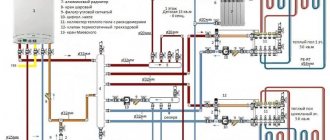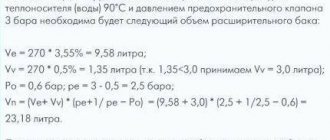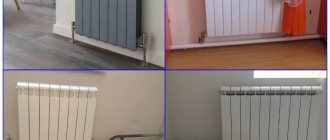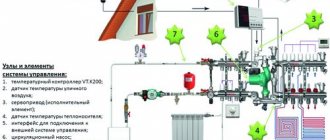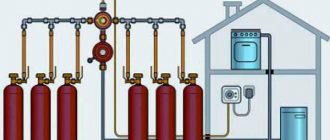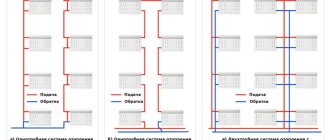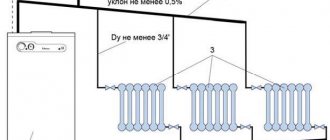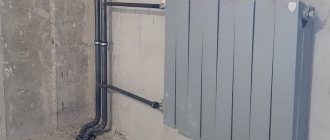Have you decided to make a private house your permanent place of residence? Or maybe the summer season lasts all year round in your family and winter weekends outside the city are a common thing for you? Then the question of heating your nest is extremely relevant. Today, perhaps the most popular among all heating systems for private homes is water heating. The principle of its operation is quite simple and clear: heat is generated in a special boiler and from it, through a closed circuit, hot water is supplied through pipes to heating devices.
But this is a general principle. Depending on the heating method (gas, electricity, etc.), the circulation method, the heating systems used, as well as other characteristics, water heating is divided into many types. It is this topic that we will cover in detail in our article.
All water heating systems for a home can be divided into two groups: using natural or forced circulation of water.
Heating with natural circulation
Example of a single-pipe system with natural circulation
Systems with natural circulation, or gravity flow as they are also called, have been used for quite some time. From the name itself we understand that they work without the help of special devices (pumps), and their work occurs due to natural physical laws.
We all probably remember from school physics lessons that a heated liquid or gas always moves upward. It is precisely this principle that underlies such heating. Heating up in the boiler, the water begins to move up through the pipes. Having reached the furthest heating device, it begins to go down back to the boiler, where it heats up again and circulates upward. When installing a system with self-circulation, a slope must be created in the water return section. And at the coolant supply, at the highest point of the system, it is necessary to install an expansion tank, which will act as a buffer compensating for the increase in liquid volume.
Advantages of gravity heating
As already noted, gravity water heating systems at home have been used for quite a long time and have already proven themselves, as they have certain advantages:
- Cheapness. After all, this system does not require the installation of additional equipment.
- Easy to install and repair (it’s even possible to build a heating system in your own home yourself).
- Work in the absence of electricity. For some time, until the boiler temperature drops below 50 degrees, the liquid will continue to circulate through the system.
- Almost completely silent operation, again due to the absence of a pump.
Disadvantages of gravity heating
But with all the above advantages, heating systems with self-circulation have many disadvantages that make it inappropriate to use this method of heating a house today.
- It is impossible to use this type of system for large rooms. Even for a two-story private house, water circulation will be difficult.
- Temperature difference in heating devices. The farther the room is from the boiler, the colder it will be there. Moreover, the difference can sometimes be significant - up to 5 degrees.
- Heating regulation is difficult. Firstly, the system will start working only when the boiler heats up to 50 degrees; accordingly, you will not be able to make the heating power in the house lower than this mark. Secondly, even when installing heat regulators, the temperature error will be from 3 to 5 degrees, which is quite significant.
Such systems are gradually losing their relevance and are being replaced every year by more modern compulsory systems. We recommend that you use water heating with natural circulation only if you want everything simpler.
Best answers
Konstantin Sukhorukov:
Only the heating engineer did not say what would happen to the boiler heat exchanger from the effects of antifreeze. If you want to use anti-freeze, then use liquids based on propylene glycol. And you can pump it without using a water pump, using a regular car pump and a lockable container with two fittings.
Larisa:
pump and hose
Alexander Bakushev:
open the emergency light and fill it until it runs out!
Andrey:
Pump a small container in the usual way and into it a cheap submersible pump, through a hose to the make-up tap, control the pressure using a standard pressure gauge, bleed air, pump and pump. Pre-pressurize the system with network water, check its operation under temperature changes. Evaporation of antifreeze and antifreeze inside a living space is goodbye to health and vision. for these reasons, fill it with an aqueous solution of drinking alcohol (vodka). Moreover, if the system is new and its volume is not very large, get a supply of the strategic product.
Bely Oleg:
Make two fittings in the canister, pour in anti-freeze, one hose goes to the boiler, and pump air into the other with a compressor from the refrigerator. The compressor from the refrigerator presses up to 8 bar - this is definitely enough for you. Productivity is just low. But they cannot pump any electrically conductive liquids - the windings there are not protected in any way...
Denisochka:
Where did the need for glycol coolant come from? When using it, heat transfer is reduced and boiler maintenance becomes more difficult, especially if the boiler is double-circuit with one heat exchanger. For almost any heating system, the best coolant is water.
Heating with forced circulation
So, we see that systems with natural circulation of liquid have a number of rather significant disadvantages. An alternative to them are systems with forced circulation, which use additional equipment that increases the flow of coolant in the system. Namely the circulation pump.
Yes, this type of water heating at home will be more expensive and complex, but you get many advantages:
- Possibility to heat a large room. We have already said that natural circulation is not suitable for large houses. If you are the owner of just such a thing, then your only option is a forced circulation system.
- Complication of the system. By installing a pump, you do not depend on such an indicator as pressure. Therefore, what was an obstacle in a gravity system is not a problem in a forced one. For example, you can now increase the number of pipe bends if the layout of your home requires it.
- Use of smaller pipes. Agree, the neat appearance of the heating system is not the last indicator that is worth paying attention to.
- Less dependence of heating quality on the presence of air in the system. With self-circulation, the entry of air into the system would significantly complicate the transportation of coolant through the pipes. A forced system solves this problem, but in the case of installing metal pipes, special expansion tanks with air vents and fuses should be used in order to avoid corrosion of the system.
- Possibility of using more wear-resistant and lightweight plastic pipes.
- Concealed installation of pipes is possible. You can hide pipes in screeds and walls without any problems
Water temperature and pressure in heating networks
The normalized temperature in water heating systems depends on the air temperature outside the building:
- If outside the window it is not below zero degrees, then the temperature of the coolant in the supply pipeline is maintained within 40-45 degrees. In this case, the return water will be at a temperature of 35°C.
- If the temperature outside is 20 degrees below zero, then water with a temperature of 67-77°C circulates in the supply line. Then the coolant in the return will be no colder than 53 degrees.
- When the outside temperature drops to -40°C, the hottest coolant (+95°C) is supplied to the heating devices. In this case, the return temperature can reach 70 degrees.
In networks with natural circulation, the pressure inside the circuit is slightly higher than the static pressure. In one-story buildings with forced coolant flow, the pressure in the heating pipeline is maintained in the region of 1.5-2.5 bar. As the number of floors increases, the pressure in the network increases. So, in five-story buildings it reaches 4 bar, in nine-story buildings - 7 bar, and in high-rise buildings it reaches 10 bar.
Types of water heating systems
Now let's look at the options for installing water heating. As in the case of the circulation method, we have a simpler and cheaper option, which is inferior in technical characteristics to a more complicated and expensive one.
Single-pipe heating systems
The first - simple and cheap - is a single-pipe water heating system for a house, in which the liquid will sequentially pass through all pipes, radiators and other heating devices, if they are present in the chain, and return to the boiler through the return pipe. This option is better suited, again, for a small room.
The disadvantage of such systems is the impossibility of their proper balancing. The first appliance is always hot, the last one is always warm.
Two-pipe heating systems
For larger premises, it is better to opt for a more advanced two-pipe system. In this case, the bottom connection of the radiators will be used. But such a heating installation will become truly perfect if you connect a circulation pump. Otherwise, heating distant rooms will be difficult.
In addition, it is possible to reduce the cooling rate of the liquid in the system by installing special bypasses on each of the batteries, as well as regulators for the supply of liquid to a separate radiator.
The difference between a two-pipe water heating system is the laying of a single pipe to the farthest radiator, from which a branch is made to intermediate heating devices. Thus, having passed through the entire heating system, the coolant returns to the boiler through a special return pipe, which allows the heat transfer to be evenly distributed throughout the room.
Of course, the main disadvantage of such heating is its high cost and complexity of installation, but the comfort that you will receive in return is worth it.
Radiant heating system
Diagram of a radiant heating system
The two types of heating pipe laying described above are representatives of the perimeter method. But there is an alternative - radiation. With this installation, pipes are supplied separately to each radiator: one through which the coolant flows into the heating device, the other through which it flows back. This system allows you to adjust a comfortable temperature in each room of the house. In addition, if one of the radiators or pipes breaks down, there is no need to turn off all the heating; it is enough to do this only in the desired area.
Due to the large number of pipes when installing a radial system, all communications are mounted directly into the floor or walls, which has a beneficial effect on the interior of the house.
For radial installation, it is most optimal to use pump circulation of the coolant.
Underfloor heating
The most optimal way to evenly warm the entire room is to install water-heated floors in the house. It is possible to use only this system, or it is possible to combine it with other heating devices. For example, when radiators are installed in the rooms, and heated floors are installed in the corridors, bathrooms and toilets. That is, warm floors will be especially relevant for rooms with tiled or marble coverings.
The use of the “warm floor” system is possible with forced circulation of the coolant.
Among the advantages that water heating with underfloor heating provides are:
- Uniform heating of the room. A screed that releases heat by radiation releases it in equal shares in each square of the room.
- Rational heat distribution. Heat moves from bottom to top.
- Comfort and microclimate.
- Absence of heating devices on the walls in most cases
Main advantages
There are many reasons for the popularity of water heating, especially in country houses. Let's take a look at its main advantages together:
- You will be able to quickly and effectively regulate the temperature in each individual room of your home. For this purpose, special equipment is installed - shut-off valves and temperature regulators.
- Such a heating system can be installed in a house at almost any stage of its construction. Moreover, even if the house is completely ready, you will not have any problems installing such a heating system.
- The equipment used for installation can be very diverse.
- The water itself, used here as a coolant, has excellent characteristics. It is cheap and accessible, conducts heat well, and has good heat capacity.
- There are many wiring options for such a system. You can choose one or the other based on many parameters, such as the area of the house or your financial capabilities.
- Such systems are also universal, since almost any fuel can be used with them.
Heating pipes
Separately, we should consider the question of the types of pipes used for heating private houses. Each material definitely has its positive and negative sides. Let's figure out which option is the most optimal.
Heating with metal pipes
Metal pipes include steel and copper pipes.
Wiring water heating for a house made of steel will cost you relatively little (and this is the main advantage of this material). This metal is quite versatile, suitable for both steam and water heating. Withstands high pressure. The main disadvantage of steel pipes is that they quickly corrode. This affects not so much the quality of heating as the appearance of your home - rusty pipes are not the best interior decoration.
Copper pipes have more advantages: they are extremely durable, hold temperature well, and do not corrode. Another advantage of copper pipes is the smoothness of their inner surface, which ensures high speed of fluid movement through the heating system. The main disadvantage of copper is its high price.
It is worth noting that both steel and copper pipes are only suitable for open heating systems and cannot be installed in walls or floors. Therefore, as we see, their universality has a limit.
Heating a house with polypropylene pipes
The main advantage of polypropylene pipes is their resistance to external environmental factors: corrosion, rotting processes, exposure to bacteria and chemical compounds.
Also one of the big advantages of this material is its lightness. Other advantages follow from this: such pipes are easier to install, they are suitable for use both on a support wall and on an interior wall.
Heating made of polypropylene allows you to save fuel consumption (gas or electricity) used to heat the boiler due to the low coefficient of friction, since the coolant easily passes through the heating system. But the difference is insignificant.
In addition, polypropylene pipes are quite flexible, have different modifications with many joints, and are also complemented by a huge selection of various components, which allows the installation of complex heating systems.
And finally, heating with polypropylene pipes can be done in both open and closed systems, when all the pipes are hidden in the floor or walls.
With all the visible advantages, these pipes also have disadvantages. Firstly, with a fairly high resistance to chemical influences, such pipes are easily susceptible to mechanical influence (you can cut it with an ordinary kitchen knife). Secondly, polypropylene is not suitable for all types of heating systems. It absolutely cannot be used in combination with a steam generator, but they are excellent for the water heating we are considering. Also, water heating with polypropylene implies the presence of a large number of joints, which greatly affects the reliability of the system
Heating with metal-plastic pipes
If we talk about the advantages of metal-plastic pipes, we can highlight the same advantages as those of their polypropylene counterparts. But it is worth highlighting that they are able to maintain higher temperatures. And also, and this is their main distinguishing feature, metal-plastic bends well. At the same time, you do not have to worry about damaging it. And this fact makes this type of pipe an ideal option for a “warm floor” system.
The disadvantage is the higher price compared to polypropylene analogues.
Heating with water baseboard
At the end of our article, we want to tell you about the “last word” in the field of water heating systems. If you want to make the heat in your home invisible in the truest sense of the word, then baseboard heating is your option.
Such a heating device is a housing that looks like a regular baseboard, inside of which there is a heating element - special tubes. First they heat up, then the body, then the heat is distributed along the walls.
This type of heating is an ideal solution for our area, where mold often forms on the walls due to dampness. In addition, as already mentioned, your interior will not be spoiled by either pipes or radiators.
But this system also has its drawbacks:
- it cannot be used on walls along which furniture is installed
- for large rooms, the installation of 2-3 buildings will be required, since the maximum length of the heating circuit is 15 meters.
What is antifreeze?
A mixture whose crystallization temperature is significantly lower than that of water. Antifreeze liquids contain various additives that prevent corrosion, oxidation, scale and other negative processes.
Popular types of antifreeze on the market:
- Based on ethylene glycols. These antifreezes are the most inexpensive, most of them are domestically produced. The main disadvantage is toxicity. The substance is dangerous for exposed areas of the body and respiratory tract. Ethylene glycols are not used in open or double-circuit systems - due to the possibility of the substance entering the water supply.
- Propylene glycols are safe for humans, but because of this they are significantly more expensive than ethylene glycols, and the crystallization temperature is higher. Usually these compounds are imported.
- Glycerin based. Completely safe - even if they get into drinking water. The rarest type of coolant.
Heating with water convectors
You've probably had experience with electric convectors. There are the same ones, only water ones. They are connected to water heating according to the same rules as radiators. And they are essentially the same radiators, only with a different principle of heat transfer.
Water convectors operate on the principle of convection. Cold air comes in from below, warm air comes out from above. Due to this, the room heats up very quickly.
The disadvantages of such water heating devices include their high cost compared to conventional radiators.
If you carefully studied our article, you saw what a variety of solutions for water heating in a private home the modern heating equipment market represents. All you have to do is choose the best option based on the parameters of your own home and financial capabilities. Peace and warmth to your home!
Installation features
Before you start installing water heating with your own hands, it is worth considering the most popular and practical systems, advantages and disadvantages, installation principles, as well as suitable types of radiators.
Homemade house construction is always associated with the organization of space heating. This issue is thought through long before the start of the relevant work. There are many options. They are considered by any person who is going to provide heating for a country house with their own hands. Quite often there are cases when no one can help with advice. Company specialists charge a fee for this, which makes their services not the most profitable option. You have to think through everything yourself.
